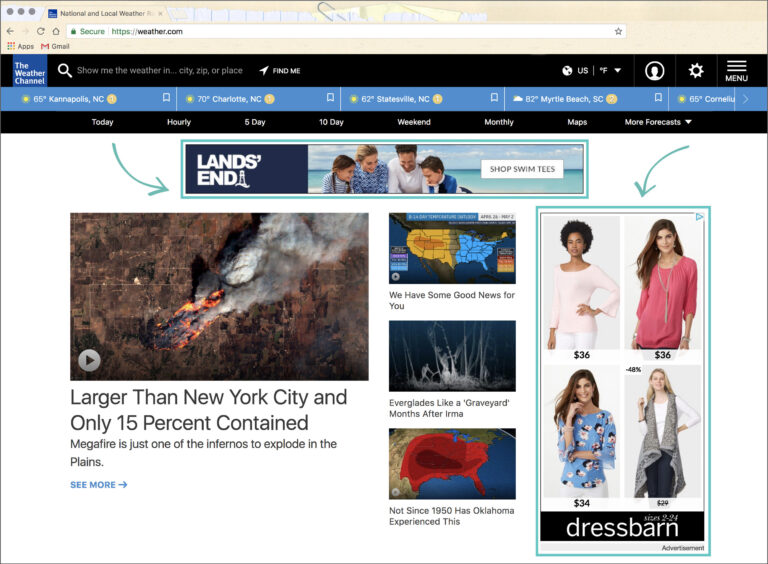Search engine marketing is one of the most effective ways to grow your business. That’s because leveraging the different SEM components allows you to drive quick wins. This includes getting as much online visibility for your brand, products, or services and driving conversions.
What is Search Engine Marketing?
SEM is the use of paid channels to promote your business and appear on search engine results.
Think of an SEM campaign as akin to going to an auction. You will bid on keywords that Google and Bing users are likely to type in on search engines when looking for a business like yours. Bring in other factors, such as your ads’ quality score, and it will likely appear at the top of search results.

SEM ads often come in various formats like text-based ads, shopping ads, and banner ads. They are also called pay-per-click ads, as you only need to pay when someone clicks on it.
SEM vs SEO
There are people who often interchange search engine marketing with search engine optimization. What they do not know is that there is a difference between the two.
As previously mentioned, SEO is improving your business’s online presence on organic search results. When we say “organic” it means that you can rank your website by optimizing its on-page, off-page, and technical components. You did not pay the search engines for your website to appear on the first page.
On the other hand, SEM refers to a system where you pay an ad platform to make your website appear on relevant search queries and content. This means that your paid online presence includes search ads, banner ads, and other components.
However, having a significant marketing budget is not enough to ensure that your online ads will work.
The Foundations of an Effective SEM Campaign
Your marketing budget is just one part of the equation when it comes to SEM. That’s because an ad platform will look at two key factors to determine your ad’s rank:
- CPC Bid. Your cost-per-click (CPC) bid refers to the highest amount you are willing to pay whenever someone clicks on your ad.
- Quality Score. This is Google’s way of rating your ad depending on the following factors:
- Relevance of each keyword in an ad group
- Quality and relevance of the landing page
- Relevance of your ad copy
Your CPC bid and quality score will determine your ad rank. The higher your ad rank is, the better the chances that your ad will appear on the first three spots of good search results.
5 Tips to Improve Your Ad’s Quality Score
You online advertising budget is something that you can manage. Whether you have $100 or $1,000, this can determine the number of keywords that you can bid.
Meanwhile, how your ads can have a high-quality score is somewhat of a mystery. But that does not mean that you cannot do anything about.
To ensure that your ads will appear on the top three spot whenever someone uses your target keywords, you need to boost your ad rank. For that to happen, you need to improve your ad’s quality score. And here are five ways to do it:
Find the Right Keywords
Keywords are an integral part of an SEM campaign. That’s because search queries can help you determine whether you are attracting the right people to your business. It also allows you to find out whether a specific keyword is bringing in ROI.
You can use a keyword research tool to discover queries that are relevant to your ad and business. It will help if you use a tool that helps you determine the cost of keyword and its search intent. That way, you can quickly conversion or sales-drive keywords and come up with an online advertising budget.
Organize Your Keywords
To help maximize your ad budget, your SEM campaign must have a robust keyword grouping. That’s because a well-thought-out account structure can help increase your ad’s quality score and decrease cost-per-click.
How can you effectively organize your account structure?
Based on the illustration above, your campaign is divided into ad groups. Each group is composed of your ads and their respective target keywords. Also included in the ad is the landing page where you will redirect people who click your ad.
At ArisAlex, we recommend creating two types of campaign:
- Awareness-driven campaign. These are SEM ads that are meant to build awareness about your business. In this type of campaign, it would be practical to uses keywords with informational or navigational search intent like (i.e., “company name + website” or “company name + office address”).
- Conversion-driven campaign. These are SEM ads that are meant to drive sales, for example. As such, it would be practical to use sales-drive keywords (i.e., “product + pricing” or “where to buy + product”)
However, there are various strategies that you can apply when building a campaign structure, each of which has its pros and cons. From there, you can create an ad group based on the recurring themes you see on your keywords. Pair with a well-written ad copy and optimized landing page, and your ad structure is all set!
Add Negative Keywords
Negative keywords are search terms that you use to let ad platforms know that you do not you’re your ads to appear whenever someone types such queries.
For instance, you are running a PPC campaign to promote and sell Air Jordan shoes. It is likely that the ad platforms will associate your ads with the search term “Michael Jordan” because they have something in common. However, not everyone who types in the basketball player’s name on Google intend to buy shoes.
Hence, you would want to add “Michael Jordan” as a negative keyword by writing “-Michael Jordan” in your keyword group.
Refine Your Ad Copy
Your ad copy is the part of the online ad that people see. It can be a text, image, or a banner.
The key to writing an effective ad copy is knowing its different components:

When you know the different parts of a PPC ad, you can easily refine your ad copy. Here are some quick tips:
- Write attention-grabbing headline
- Use a relevant display URL
- Share specific information in your ad copy
- Highlight your unique selling proposition
- Include a compelling call-to-action
- Use ad extensions
- Run an A/B test
Optimize Your Landing Page
Lorem ipsum dolor sit amet, consectetur adipiscing elit. Ut elit tellus, luctu
Your landing page is where your target audience will “land” after clicking your ad.
As mentioned earlier, the quality and relevance of your landing page can impact your ad’s quality score. It can also help reduce your ad cost. Hence, optimizing your landing page is essential.
One of the things you can do is continuously monitor and optimize your ad assets like the audience you want to target, ad copies, and your landing page design.
s nec ullamcorper mattis, pulvinar dapibus leo.
4 Types of Online Advertising Tactics That Business can Use
Now that you know how to build an effective SEM campaign and increase its chances of getting the views and clicks that it deserves, it is time what kind of ads you can run online.
NOTE: Using one or a combination of these ads can help your business establish its online presence, convert your target market into paying customers, and get quick wins (a.k.a. sales).
Paid Search Advertising
Paid search advertising is often the first thing that comes to mind when we talk about online advertising. This is the kind of ad that you see on top of the search engine results and can come in the form of text or shopping ads.

Paid search ads can help you gain quick wins, such as immediate sales, since your ads will appear whenever someone types in your target keywords. This means that search ads are designed for people who are actively looking for a solution that your products or services can cater.
Display Advertising
Display advertising is another common type of online ad. This refers to the banners, pop-ups, and other promotional images that you see on a website.

Banner and pop-up ads can help you build brand awareness for your business in a highly targeted environment. For instance, an online shoe store can run display ads on fashion and lifestyle websites. The only caveat is that they have low click-through rate since people tend to ignore banner ads or use ad blockers.
As such, it would be best to run display ads in addition to other SEM and digital marketing efforts that you are doing.
Social Media Advertising
Social media advertising refers to any paid campaigns you run on social media platforms. It is deemed one of the best ways to reach your potential customers. That’s because 7 out 10 adults in the US have at least one social media account.
What’s great about social media advertising is that you can set specific parameters when running a campaign. This ensures that only your ideal customers will see and interact with your ads.
Native Advertising
Native ads are paid content that blends into other web content. Also called as Sponsored Post or Sponsored Content, it can be a blog post or a promotional email.
You can choose to do native advertising if you want to run a non-obtrusive promotional campaign for your business. This is also an excellent workaround for ad blockers, ensuring that your content gets as much ad impression as possible.
8 Tools You’ll Need to Run an Effective SEM Campaign
Setting up a Search Engine Marketing campaign can be tedious. That’s because you need to conduct a thorough keyword research, create your ad copy, build your landing page, and monitor your campaign’s performance.
Luckily, you can use the following tools to build and run an effective paid ad campaign:
Keyword Research Tools
Keyword research is crucial in running a paid ad campaign because it gives you an insight into your target market’s behavior. Plus, keywords help you attract the right people and discover which search terms are bringing your ROI.
Google Keyword Planner
The Google Keyword Planner is a free keyword research tool that lets you find the right keywords to target. This includes the search volume, level of competition, and cost-per-click. With the help of this tool, you can quickly generate a list of keywords to target and come up with a marketing budget.
SEMrush
SEMrush is a powerful keyword research tool. For one, it makes it easy for you to find the right keywords that you include in your paid ad campaign. You can also use this tool to monitor your competitors’ target paid keywords and some of the ads that they run in the past. That way, you can have an idea how their top-performing ads were built.
Ad Creation Tool
Once you’ve figure out what keywords to target in your SEM campaign, the next step is to build a stunning ad that can grab your target market’s attention and compel them to take action.
Canva
While known as a beginner-friendly, web-based graphics design tool, you can also use Canva in creating attention grabbing ads. Moreso if you are running social media and display ads campaign. The best way to maximize this tool is to create visual content in various formats so you can run an A/B test without having to compromise the quality of the graphics.
Smart Ads Creator
Built by WordStream, the Smart Ads Creator allows you to quickly create displays ads by grabbing the content from your landing page. This tool will build and customize your ad based on the text, images, and colors used on your landing page. But what makes the Smart Ads Creator awesome is that it can automatically create display ads in seven different sizes, which you can use on the Google Display Network.
Landing Page Builders
As mentioned earlier, the quality of your landing page can impact your ad’s quality score. And low quality score can mean low ad rank, preventing your ads from appearing on the top three positions of the search result page.
You can use different pages on your website as a landing page. But if you want to retain your site visitor’s attention to your content, a landing page builder can come in handy.
Instapage
Instapage allows you to build high-quality landing pages with less effort. Whether you have a web design or coding experience, you can use this tool to create professional sales pages. Aside from its intuitive visual editor, Instapage also enables you to run A/B test on landing page. That way, you would know which web design elements helps you achieve your conversion goals.
Unbounce
Like Instapage, Unbounce lets your build landing page with ease – thanks to its drag-and-drop editor more than 100 templates. Moreover, this tool allows integration with an email marketing tool and Google Analytics. As such, you can run a seamless marketing campaign and closely monitor how your landing page is performing.
Ad Monitoring Tools
Just like with any digital marketing tactics, monitoring and analysis is integral in running an SEM campaign. For one, you cannot improve what you cannot measure. Second, you will not know whether you paid ads are helping you bring desired results. Thus, you will need any of these ad monitoring tools:
Google Analytics
The use of Google Analytics is not limited to monitoring organic website traffic. You can also use it to monitor your SEM campaign’s performance. It comes with tracking features that can help run a detailed analysis of how your PPC ads are doing. This includes knowing which platforms and keywords are bringing in most traffic and conversion.
Reporting Ninja
Reporting Ninja is an easy-to-use PPC reporting tool that lets you create customize reports for your paid ad campaigns. It features editable templates and drag-and-drop widgets for report customization. What’s great about this tool is that it allows you to monitor your ad campaigns from Google, Bing, Facebook, Instagram, and other platforms all in one place.
Build an Effective SEM Campaigns and Get Quick Wins
When done right, search engine marketing can help boost your website traffic and drive quick wins for your business. This includes knowing whether you are targeting the right market, improving your conversions, and increasing your sales.
Nonetheless, keeping the foundations of an effective SEM campaign in mind is crucial in achieving your marketing goals and maximizing your ad budget. That’s why it is recommended that you do the following with the help of the tools mentioned above:
- Find the right keywords
- Organize your keywords into groups
- Add negative keywords
- Refine your ad copies
- Optimize your landing page
By following these tips, you can run an effective SEM campaign and get quick wins.





